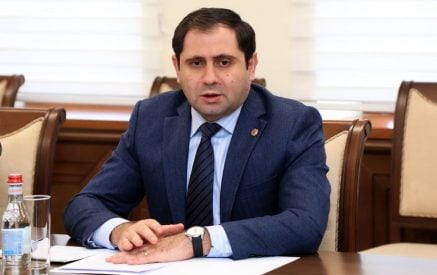by Hetq
Armenia, officially and in practical terms, years ago assumed the role of guaranteeing the security of the Republic of Artsakh.
During the 2020 Artsakh war, Armenian PM Nikol Pashinyan’s administration failed to provide such security, losing the entire Artsakh district of Hadrut and parts of the districts of Shushi, Askeran, Martuni and Martakert. The fortress town of Shushi was also lost.
By the agreement of November 9 Pashinyan handed over Aghdam, Kelbajar and Lachin regions adjacent to the former Nagorno-Karabakh Autonomous Oblast (NKAO) to Azerbaijan. Azerbaijani forces captured Fizuli and Jabrail in the war, as well as most of Zangelan and Ghubatlu. Armenian forces withdrew in December 2020 (according to a verbal agreement), from the remaining small areas that were liberated in the 1990s and became part of the Artsakh Republic.
Read also
On May 12, 2021, Azerbaijani armed units, taking advantage of the inaction of the militarily defeated Pashinyan administration, captured a number of strategic hills in Armenia (Syunik and Gegharkunik), and forced Armenian troops to withdraw from their poorly equipped military positions.
In May 2021, Azerbaijani troops occupied a minimum of 32 square kilometers (3,200 hectares) in the Vardenis region of Armenia’s Gegharkunik Province (in the border section from the Norabak-Karvachar road to Big and Small Al lakes.)
3,200 hectares is equal to 4,482 football fields.
Armenian positions in red. Azerbaijani positions in blue. Yellow shaded area shows Azerbaijani occupied land
Using a Google map (the aerial images taken by the European Airbus and American Maxar Technologies satellites), Hetq has measured the territory of Armenia occupied by Azerbaijan in the spring of 2021.
How we measure
Google Maps and Google Earth regularly update their satellite imagery. However, it is not the whole system that is updated, but specific segments depending on the images received from the satellites.
As it is known, Azerbaijani troops have also appeared in the vicinity of the Kut settlement in Vardenis since the spring of 2021, but we have measured the size of occupied Armenia sovereign territory south and southeast of the neighboring village of Norabak. (This is why we note at least 3,200 hectares). The last satellite image of the Kut border area in Google Maps and Google Earth was taken on October 18, 2019, before the occupation, and south of Norabak, on October 23, 2021, after the occupation.
Thus, we base our findings on the positional situation as of October 23, 2021. We measured the size of the occupation by drawing a straight line between the Azerbaijani vanguard positions. The 3,200 hectares is the area that is now behind these positions. However, Azerbaijani troops monitor a much larger area from their positions on the strategic heights.
As can be seen in the map, the area of the first occupied zone, from the Norabak-Karvachar road to the neighboring positions of Nerkin Shorzha, is 11.4 square kilometers (1,140 hectares). The area of the second zone, 20.7 square kilometers (2,070 hectares), which includes the section from Verin Shorzha-Tsar road to Mets Tsarasar (elevation – 3441 meters, the mountain is outside the territory of Armenia according to Google Maps.)
Azerbaijan controls the highest point of this part of the border
The Armenia-Azerbaijan border runs from the Sotk gold mine to the Big and Small Al lakes along the Eastern Sevan Mountain range. One of its highest peaks is Tsarasar, which is 3,426 m high. (Blue sign in picture and map). This mountain, the dividing point of the Armenian-Azerbaijani border, appeared 3.8 kilometers behind Azerbaijani military lines in May 2021. Thus, Azerbaijani troops advanced 3.8 km in a straight line in the Tsarasar section. The whole Vardenis region can be observed from the top of the mountain, including Lake Sevan, which is 29 km from the shore to Tsarasar. The distance from the center of Vardenis is 22 km. This area vulnerable to artillery.
On May 27, 2021, on the eve of snap parliamentary elections, Prime Minister Pashinyan circulated his famous thesis of the mirror withdrawal of troops in the Sotk (Gegharkunik) – Khoznavar (Syunik) section. Responding to Azerbaijan’s false claim that Azerbaijani troops had advanced to clarify the border, Pashinyan offered to hand over border monitoring to a third party.
“International observers are coming, either from Russia or OSCE Minsk Group Co-Chair countries. They will come and take up positions to ensure that troops on both sides… If this is the case, why do we, or they, need soldiers on the top of that mountain covered in snow for half of the year?” Pashinyan said at the time.
On May 27, 2021, shortly after Pashinyan’s remarks, Armenian Foreign Minister Ara Ayvazyan resigned.
At a farewell meeting with ministry staff in June, Ayvazyan said he decided to leave to “ensure that there is never any suspicion that this ministry could take measures or accept certain ideas, initiatives, which go against our national and state interests”.
Last month, Ayvazyan revealed that it was Pashinyan’s border policy that led him to leave office.
Former Armenian Human Rights Defender Arman Tatoyan, noting Azerbaijani advances in the Parukh-Khramort section of Artsakh, also criticized Pashinyan in this regard.
“The government’s proposal to withdraw troops in parallel is destructive for the security of Armenia and Artsakh. The objective evidence is the recent illegal actions and invasions of Azerbaijan in Artsakh (Parukh, Khramort, Karaglukh). This idea was deplorably brought to the public domain, promoted and became part of an agenda favorable to Azerbaijani interests.”
Pashinyan’s proposal never saw the light of day because Ilham Aliyev, to put it mildly, paid no heed. Instead, Azerbaijani armed groups continue to pose a threat to the population of the entire Vardenis region, and especially to residents of the border villages of Kut, Norabak, Nerkin Shorzha and Verin Shorzha.
Moreover, on January 11 of this year, Azerbaijani troops launched new attacks in this area using firearms, artillery and unmanned aerial vehicles. They targeted Armenian military positions, killing three soldiers and wounding others.

























































